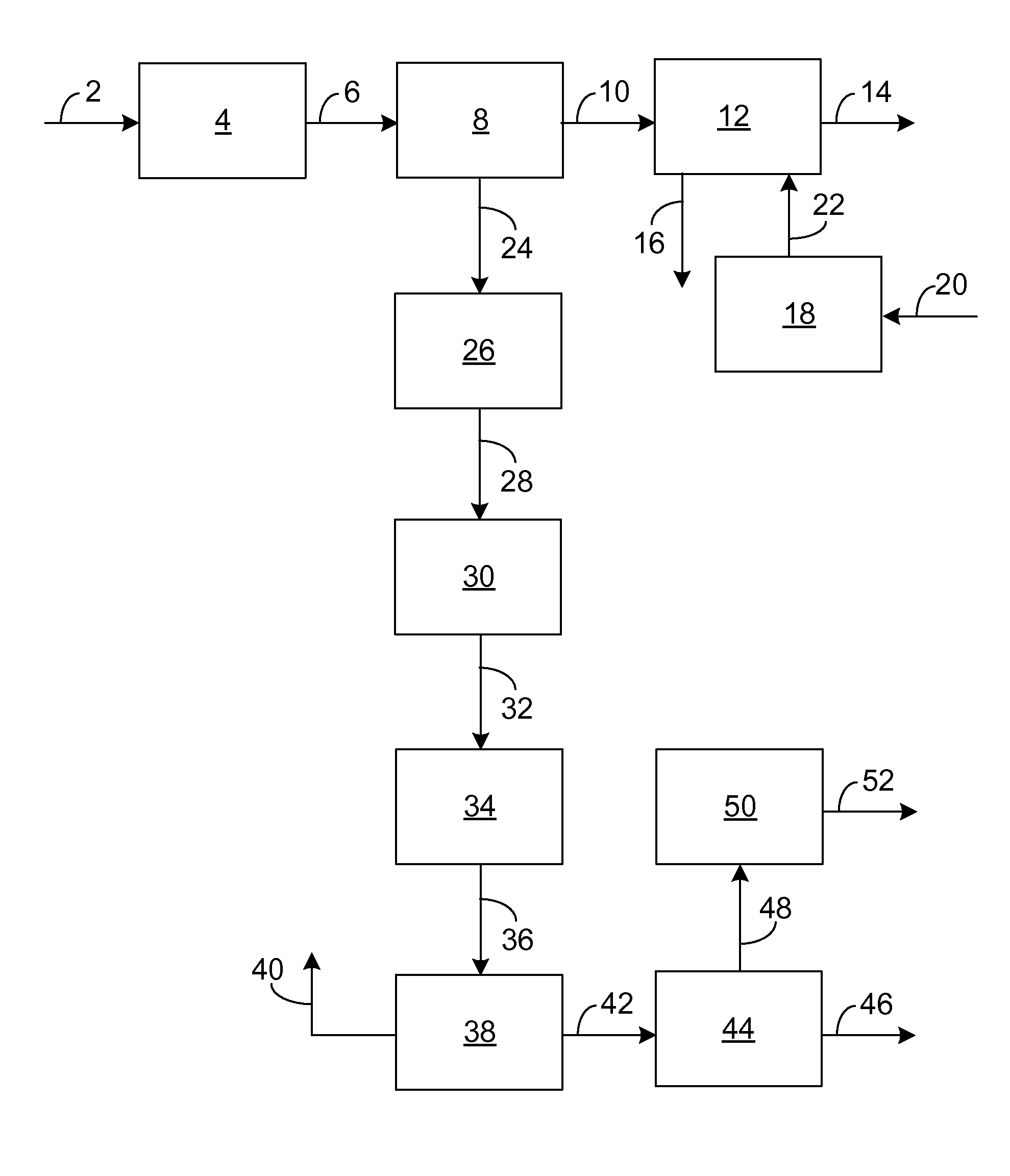Removal of sulfur compounds in an acid gas stream generated from solvent-based gas treating process
- Summary
- Abstract
- Description
- Claims
- Application Information
AI Technical Summary
Benefits of technology
Problems solved by technology
Method used
Image
Examples
example 1
[0013]A natural gas stream at a flow rate of 19.6 MM m3 per day at 43 bar and 45° C. with a composition shown in the following Table is to be treated for removal of water, carbon dioxide and sulfur impurities before being sent into a LNG train for cryogenic treatment. Using the process flow scheme from the current invention as shown in the FIGURE, mercury is removed by an adsorbent such as copper based UOP GB 562 adsorbent. Carbonyl sulfide is partially converted to hydrogen sulfide in the same adsorbent bed. The carbonyl sulfide level is further reduced by the hybrid solvent unit down to about 2 ppm. Carbon dioxide levels are reduced to below 50 ppm and hydrogen sulfide to 1 ppm by the same solvent unit. The product gas from the solvent unit is sent to an adsorbent bed such as a 4-bed adsorbent dehydration unit to lower the water level to 0.1 ppm. The final product compositions are also shown in the following Table.
[0014]The acid gas released from the solvent unit, which contains m...
example 2
[0016]This example is the same as Example 1 except that the acid gas is compressed to about 25 bar and the gas is chilled to −25° C. Under these conditions, the necessary compressor power is reduced from about 1.9 Mw in Example 1 to about 1.5 Mw for this example. However, the chiller duty requirements are increased from 2.4 MMBtu / hr in Example 1 to 3.9 MMBtu / hr in this example.
TABLEGas Compositions for Example 1FeedProductCO2-richLiquidTemperature, ° C.28.8224.00−42.3039.96Pressure, bar43.4842.5010.0010.50Molar Flow, MM m3 / day18.9718.760.1930.016Mass Flow, kg / hr603969.17587646.2614169.411919.30Mole FractionsNitrogen3.80E−033.84E−0300Carbon Dioxide9.60E−035.44E−040.8881758.25E−02Methane0.9139729.24E−016.11E−025.32E−07Ethane4.19E−024.20E−020.0343671.95E−02Propane0.0172941.73E−021.11E−026.05E−02Isobutane3.10E−033.07E−031.59E−035.32E−02n-Butane4.80E−034.76E−038.40E−040.103287n-Pentane1.60E−031.49E−032.46E−060.153618Isopentane1.40E−031.30E−031.48E−050.134018n-Hexane2.30E−032.05E−034.25E−...
specific embodiments
[0017]While the following is described in conjunction with specific embodiments, it will be understood that this description is intended to illustrate and not limit the scope of the preceding description and the appended claims.
[0018]A first embodiment of the invention is a process for treating a natural gas stream comprising a) sending the natural gas stream to an absorbent unit containing a chemical solvent and a physical solvent for removal of carbon dioxide, hydrogen sulfide, carbonyl sulfide and organic sulfur compounds to produce a partially purified natural gas stream; b) then sending the partially purified natural gas stream to a dehydration unit to remove water to produce a natural gas product stream; and c) removing the sulfur compounds from the absorbent unit to produce a liquid comprising the sulfur compounds. An embodiment of the invention is one, any or all of prior embodiments in this paragraph up through the first embodiment in this paragraph further comprising sendi...
PUM
 Login to view more
Login to view more Abstract
Description
Claims
Application Information
 Login to view more
Login to view more - R&D Engineer
- R&D Manager
- IP Professional
- Industry Leading Data Capabilities
- Powerful AI technology
- Patent DNA Extraction
Browse by: Latest US Patents, China's latest patents, Technical Efficacy Thesaurus, Application Domain, Technology Topic.
© 2024 PatSnap. All rights reserved.Legal|Privacy policy|Modern Slavery Act Transparency Statement|Sitemap

